PARISH OF NEWRY
by Sr. Dr. Evelyn Kenny
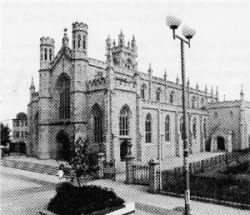
The Cathedral of Saint Patrick and
Saint Colman serves as the parish church
for Newry and the mother church of the
Dromore Diocese.
Long before Newry became an industrial
market town - and, in recent times, a city - it was a place
of note due to its topographical and geographical position.
Legend associates it with events dating from pre-Christian
times such as the renowned "T�in B� Cuailgne" (the cattle
raid of Cooley). Its position at the head of Carlingford
Bay, which afforded an opening into the very heart of the
country, ensured its commercial importance.
The parish of Newry consists of circa
6,500 families and now encompasses the following townlands:
Ballyholland (Baile Cholm�in: Colman's townland),
Ballynacraig (Baile na Creige: the townland of the rock),
Carmeen (Carn M�n: smooth cairn), Carneyhough (Corr na h�tha:
the round hill of the ford), Cloughenramer (Cloch�n Reamhar:
large causeway), Commons (an English term), Creeve (Craobh:
Branch), Damolly (an d� Mhaol: the two bald hills), Derrybeg
(Doire Beag: little oak-grove), Derryboy (Doire Buidhe: the
yellow oak-grove), Drumcashellone (Droim Caisil Eoin: hill
of Owen's stone fort), Grinan (Grian�n: sunny place),
Lisdrumgullion (Lios Drom gCuilinn: fort of the holly hill),
Lisduff (Lios Dubh: black fort). The parish traces its
origin back to the time of St. Patrick, who, on a visit
here, according to tradition, planted two yew trees close to
the tidal limit. That event was remembered in Newry's former
coat of arms which bore the name I�r Cinn Tr� (Iubhair Chinn
Tragha: The yew trees at the head of the strand) and
depicted a mitred Abbot seated between two yew trees. If
this tradition be true, it would indicate that Newry had a
Christian community circa 461 A.D.
After the time of St. Patrick, the
practice of the monastic life spread. There was a Celtic
monastery at Derryleckagh where the monks lived frugally,
supplying their needs through their own labour, living in
small, simple cells and coming together for worship. As well
as inspiring and converting the local inhabitants, the
monks, in all probability, set out to spread the Gospel
message on the continent of Europe.

The golden age for Newry and its environs
ended, however, circa 800 A.D. with the increasingly
frequent raids of the Vikings who carried off priceless
sacred artefacts - chalices, crosses and the Books of the
Gospel. Despite this, the Faith flourished and, in 1144, a
Cistercian Abbey was founded, through the influence of St.
Malachy, by monks from Mellifont. The monastery, dedicated
to the Blessed Virgin Mary, St. Patrick and St. Benedict,
flourished on account of the patronage of Maurice O'Loughlin.
King of Ireland, who granted it a Charter in 1 157 - the
only one of its kind still extant - bestowing on the
monastery over 6,000 acres, including the townlands of
Ballynacraig, Sheeptown, Carnmeen, Comglean, Castle Enigan,
Crobane, Croreagh, Corcreeghy, Conlea, Greenan, Turmore,
Carnacally, Ballyholland, Derryleckagh, Lisduff, Ryan and
Benagh as well as extensive lands in Armagh and Louth. The
Abbey's first and most famous Abbot was Finn Mac Gorman,
compiler of the famous Book of Leinster. The
monastery and the surrounding town thrived commercially. At
one stage, a mitred Abbot possessed the Lordships of Newry
and Mourne in which he exercised episcopal jurisdiction.

According to a map of Newry dated April
1587, the ancient monastic public Church stood in Abbey
Yard. Patrick Keenan, the noted historian, stated: "The
great Church of Newry, its walls adorned with precious
paintings and sculptures, stood at the head of Hyde Market
(now St. Colman's Park) for on this spot in later times
human remains were unearthed together with ecclesiastical
ornaments worn only by Abbots and Bishops." (Old Newry
P.1-2). It is believed that the Abbot's House was
situated in what was originally McCann's Bakery in Castle
Street. The Abbey Cemetery stood in Abbey Yard and was in
existence until the beginning of the 19th. century when it
was removed by the Corry family. In 1162, the Abbey, its
books and the yew trees planted at the head of the strand,
were destroyed by fire, according to the Annals of the
Four Masters. It was rebuilt and remained undisturbed
for over four centuries.
However, the establishment of the Protestant
religion by law had its effect on Newry. John Prowte was
Abbot in 1535 when the Abbey of Newry, in compliance with a
mandate of Henry VIII, was converted into a Collegiate
Church for secular priests with the Abbot as Warden and the
monks as Vicars Choral. This change was effected by Arthur
Magennis who did homage to Henry at Greenwich in 1542. In a
letter to his Irish College, Henry wrote:
"We have made Mguinez (.i. D�nal �g)
Knight and to him we give in ready money 100 marks. We
have also made Arthur Mguinez Knight and given him �50
in money and also granted his suite that the cell of
Newry, as yet unsuppressed, should be converted to a
College for secular priests."
For endowment, the College was to have
the entire Abbey revenue minus a sum of four marks payable
annually to the Crown. This arrangement was obviously a ruse
by Arthur Magennis to save the Abbey from suppression, but
it did not work. Formal suppression took place by Royal
Edict of Edward VI on 21st. May 1548 when the Abbot and his
three priests were pensioned off, the Abbot receiving �15
per annum and the priests - Frs. Arthur Mac Gillabuy (McEvoy),
D�nal Mac Gillabuy and Eneas O' Sheyll (O'Shiel) - �2 each.
An Inquiry reported that clustered around the Abbey were 72
cottages, two salmon weirs and a water mill. On the
dissolution of the Abbey, the powers and privileges of the
Lord Abbot were given to Sir Nicholas Bagnal (Bagenal) to
whom a patent was granted by Edward VI. Sir Nicholas was
also given the entire property of the Abbey and it is
believed that he took up residence in the Abbot's House in
Castle Street.
The confiscation of the Abbey marked the
beginning of two centuries of persecution for the Catholics
of Newry. However, although the Abbey was officially
suppressed, it would appear that the priests stayed with
their people as Abbot Crilly was, apparently, the last Abbot
of Newry and Fr. Malachy O'Shiel O.Cist (Prior of Newry
1634-42), Fr. Robert O'Shiel and Brother Malachy O'Kea are
mentioned in the Annals. Moreover, in a letter to
General Leslie dated 13th. May 1642, General Munroe stated
that, on taking the town, "we entered into an examination
of the townsmen if all were papists; and the indifferent
being severed ..from the bad, whereof 60 with two
priests were shot and hanged, the indifferent are banished."
(Aphorismical Discovery I. p. 421).

It should be noted in passing that following the diocesan
and parochial organisation at the Synod of Rath Breasail
(1111) and the Council of Kells (1152)
Dromore remained the administrative seat
of the diocese and the ancient Cathedral of St. Colman was
the seat of the Bishop until John Todd was appointed the
first Protestant Bishop of Dromore by Patent of James I on
16th. March 1606 and, armed with Acts of Parliament, took
over the Cathedral at Dromore and other church property.
From 1642 until 1704, there is no record
of the Catholic clergy who ministered in the parish of
Newry. it was during this period, apparently, that the Mass
Rock at Ballyholland and the altar in the `reilig'
(graveyard) at Grinan were used for the celebration of Mass.
Early in the 18th. century it was reported to the government
that there were only two Mass Houses in the whole diocese
viz. in Grinan and Ballyroney. At a General Sessions of the
Peace held at Lurgan on l0th. July 1704, Patrick Donnelly
was registered as Parish Priest of Newry. This was Dr.
Patrick Donnelly, the 'Bard of Armagh,' who lived in hiding
in the neighbourhood of Newry. He was jailed twice for
lengthy periods under suspicion of being a bishop, but his
accusers could not prove it. When he died in 1716, it was
considered unsafe for a bishop to live in Newry. In 1747,
when Dr. Anthony O'Garvey became Bishop of Dromore (1747-66)
with Newry as his mensal parish, he came to live in
Aughnagun and he established Newry as the administrative
seat of the diocese. Since then, successive bishops have
resided in various areas of the town: Chapel Street
(17801801), 15-17 Boat Street (1801-1825), a residence on
the Northern side of Abbey Yard (1826-35), the 'Bishop's
House' attached to Violet Hill College (1835-1900), 'Ardmaine'
on the Fullerton Road (1903-1932) and since then in the
completed 'Bishop's House' in its own extensive grounds on
the Armagh Road.
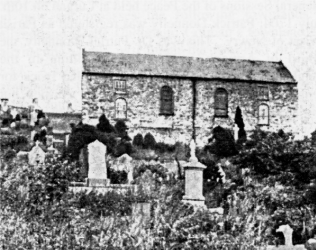
� St. Mary's
Church at the close of the 19th.
century. 'The Old Chapel'
effectively served as a
`pro-Cathedral' for the diocese for
forty years.
There are several indications that the
Penal Laws were not harshly enforced around Newry towards
the end of the eighteenth century. Circa 1740, a plain Mass
House was built in the middle of what is now St. Mary's
Cemetery in Chapel Street. Then in 1789, Dr. Matthew Lerman
(1780-1801) erected St. Mary's Chapel in Chapel Street,
which served as a Cathedral for thirty five years. St.
Mary's, however, soon became inadequate for the large
numbers of Catholics as is evident from the following
extract from The Newry Telegraph, written by a
Protestant sympathiser:
"Catholics have suffered the most extreme
inconvenience for want of sufficient space in their present
house of worship, now totally inadequate to contain their
congregation of which at least one third is obliged to kneel
outside the house, exposed to the inclemency of the
weather".

Moreover, under the Penal Laws, the only
legal schools in the country were non-Catholic institutions.
In 1792, the Irish Parliament granted Catholics permission
"to publicly teach school.... (and) instruct youths in
learning in any private Popish school" on condition that the
Oath of Allegiance was taken and permission was granted by
the Protestant Bishop of the diocese. Most Rev. Dr. Edmund
Derry (18011819) was quick to avail of this opportunity and,
under his supervision, Rev. William McMullan, a priest of
the diocese of Down and Connor, conducted a seminary called
"The Newry School" at No.6 Hill Street from March 1804 until
November 1805 when he returned to his native diocese and the
seminary closed.
In order to alleviate the overcrowding in
St. Mary's, Most Rev. Dr. Hugh O'Kelly (1820-1825), who
succeeded Dr. Derry, inaugurated plans for the building of
the Cathedral. The Marquis of Downshire was approached and,
after two and a half years, a site was purchased. The
original lease shows that a grant of the "swamp beside the
Mill Race, known as Seymour's Green" was purchased on behalf
of the parish on the 20th. September 1823. To secure a solid
foundation for the massive structure, the builders, James
Clarke of Newry, were obliged to penetrate through tidal
deposit down to twenty five feet below the surface. The
foundations rest on solid oak trees driven into the swamp.
The foundation stone was laid by Most Rev. Dr. Hugh O' Kelly
on the 8th. June 1825 and, although Dr. O' Kelly died in
1826, work progressed between 1825 and 1829 under the
direction of Most Rev. Dr. Thomas Kelly and the architect,
Thomas J. Duff, and received the generous support of all
sections of the community. This was to fulfil an agreement
made earlier in the century arising from an Act of
Parliament in 1811 which authorised a five-year levy - later
extended to nine years - on Protestants and Catholics alike
throughout the district towards the erection of St. Mary's
Protestant Church, to which Catholics agreed to withdraw all
opposition on the understanding that the Protestant
community would co-operate in the erection of the Catholic
Cathedral in the near future. The dedication ceremony of the
Pro-Cathedral of St. Patrick, as it was then called, was
performed on the 6th. May 1829 by Dr. Curtis, Archbishop of
Armagh, assisted by the Bishops of Dromore, Dublin, Derry,
Kilmore, Raphoe and Down and Connor, with Dr. James Doyle (JKL),
Bishop of Kildare and Leighlin, as preacher.
Although Dr. O'Kelly did not live to see
the opening of his Cathedral, he had the satisfaction of
seeing another of his dreams realised. Under his direct
supervision, the Diocesan School of Dromore, conducted by
Rev. John Sproule Keenan, a second cousin of William
Carleton, was opened in Lower William Street on the 12th.
May 1823 where, according to an advertisement, "Young
gentlemen will be carefully instructed in the courses best
calculated to fit them for College and for business. Besides
the branches of general instruction, declamation and
composition in the learned and polite languages will be
particularly practised...." The seminary served as a
boarding and day school with fees ranging from twenty eight
guineas per annum for boarders to one guinea per quarter for
day students, with no holidays for any students. The
curriculum for the seminary in its early years included
English, Grammar, Arithmetic, French, Geography,
Mathematics, Ancient and Modern History. Care was also taken
to "inculcate religion and form a taste for virtue and
purity of manners". Music and dancing were taught as extra
subjects.
Dr. Kelly rented the Violet Hill
buildings as a seminary in 1929. There, boarders of the
Diocesan School of Dromore - which was by this time located
at 6, Courtenay Hill, where the "parlour boarders" were also
accommodated - lived under the supervision of a Cistercian
Brother named Barbour, where they paid �10 per annum. In an
attempt to improve educational facilities for girls, Dr.
Kelly brought the Poor Clare nuns to Newry in 1830, the
first religious order to settle north of the Boyne for three
hundred years.

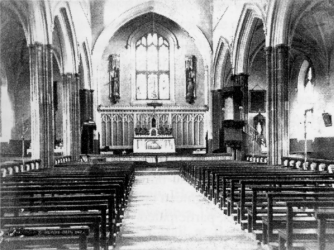
The Cathedral in its early years
lacked the rich mosaic decoration for
which it became renowned. The transepts
and bell tower were added 1888-90.
Newry Cathedral is unique in that it was
completed before the passing of Catholic Emancipation in
Ireland and also because its dedication was the first
ceremony of its kind in Ireland following
the Roman Catholic Relief Act. Indeed, it provoked a
discussion in the English House of Commons. It was visited
by `The Liberator,' Daniel O'Connell, in 1829, 1831 and
1839.
In its original form, the Cathedral was
far from the imposing edifice that we treasure today, its
total length when completed in 1829 being one hundred and
twenty feet long by seventy feet wide, standing back almost
sixty feet from Hill Street. The interior was not decorated
due to lack of funds. By 1836, it had cost �8,000, raised by
subscription by people of all denominations. In 1851, Most
Rev. Dr. Michael Blake who was the first Bishop to be
consecrated in the Cathedral - on the 17th. March 1833 -
decorated the interior, while his successor, Most Rev. Dr.
John Pius Leahy O.P., purchased the massive bell. That same
year, Dr. Blake was instrumental in bringing the Christian
Brothers to Newry and, in 1855, the Sisters of Mercy. He
also secured the Violet Hill property for the diocese in
that on the 6th. June 1834, the property was sold to James
Magill and Roger Marley for �200. It would appear that they
were acting on behalf of the Bishop as, on the 21st.
September 1834, they, by deed of conveyance, transferred the
property to the Bishop for the nominal sum of ten shillings.
In 1871, in answer to repeated requests by
the parishioners of Newry, Dr. Leahy invited the Dominicans
to set up a foundation in the town.
Between 1888 and 1890, the second phase of
the Cathedral building, costing �12,000, was completed by
Most Rev. Dr. Thomas McGivern who was appointed Co-Adjutor
in 1886 and consecrated Bishop on the 6th. March 1887. The
Papal Envoy to Ireland, Archbishop Persico of Damietta, told
Dr. Leahy that the Cathedral was not in keeping with the
dignity of the diocese. He charged Dr. McGivern with the
task of enhancing the building.
Two transepts were erected, a new
sacristy was added to the rear and a new porch was built to
the front. By 1890, the new bell tower - in which new
joybells were installed in 1898 - was practically complete.
In 1891, a High Altar was erected as a memorial to Dr. Leahy
(1.10.1854 - 6.9.1890) and the former altar was moved to St.
Mary's Chapel. An organ, donated by General Needham, M.P.
for Newry, which was formerly in the Old Chapel, was also
installed in 1891.

The third phase of the building of the
Cathedral began in 1904, during the episcopate of Most Rev.
Dr. Henry O'Neill, with G.C. Ashlin, Dublin, as architect
and Denis Neary as building contractor. When the work was
completed in 1909, the nave had been extended forty feet
towards the main street and an addition of thirty feet to
the rear made way for the new elevated sanctuary. The
sacristy was removed and rebuilt. The side chapels of the
Blessed Virgin Mary and St. Joseph and their altars, the new
tubular organ-installed in 1907, largely through a donation
of Andrew Carnegie - the heating, electrical systems and
general church furnishings were included in this major
reconstruction work from 1904-1909.

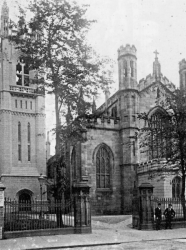
The Cathedral was extended in
length during renovations
1904-1909. This photograph, from
1891, shows an earlier frontage.
Note the short distance from the
main entrance to the bell tower.
Dr. O'Neill was also responsible for the
interior decoration of the Cathedral which exhibits some of
the finest work of ecclesiastical art in that the mosaic
artists have produced works not only of liturgical and
artistic value, but also of permanence and inestimable
worth. The mosaics and marbles were begun in 1904 and the
stained glass windows in the Sanctuary and Side Chapels were
executed by Messrs. Oppenheimer, Manchester, during the
years 1908-1914. It is interesting that St. Th�r�se of
Lisieux is portrayed in the lower portion of one of the
windows many years before her canonisation. Unfortunately,
several of the stained glass windows were shattered on the
20th. July 1972 when a bomb exploded outside the General
Post Office. When a large flour mill south of the Cathedral
was destroyed by fire, Dr. O'Neill purchased the site which
is now the Cathedral garden.
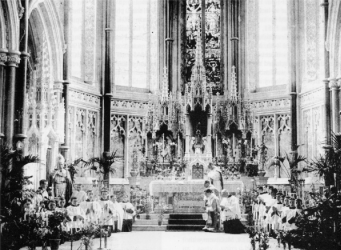
Bishop
Henry O'Neill, to the left in this
photograph. gives a blessing to the
congregation at the end of a Mass to
begin Forty Hours' Adoration in the new
Cathedral Sanctuary. 1909.
Although �30,000 had been raised for the
renovation project under Dr. O'Neill, a considerable debt
still remained. By 1918, Most Rev. Dr. Edward Mulhern, who
was consecrated Bishop in the Cathedral on the 30th. April
1916, had the debt cleared. At the request of Dr. Mulhern,
His Holiness Pope Benedict XV restored the Cathedral Chapter
by a Decree dated 25th. April 1918. At this stage, the
Cathedral ranked canonically as a Pro-Cathedral and was
called St. Patrick's. Dr. Mulhern appealed to Rome and by a
Decree of the Sacred Congregation of Rites dated 7th. March
1919, the Pro-Cathedral was raised to the rank and dignity
of a Cathedral. By the same decree, the name of St. Colman
was added to St. Patrick as joint titular "aeque principalis".

In 1920, Dr. Mulhern established the new
Parish of Saval by cutting off the following twenty-three
townlands, hitherto annexed to Newry: Ardarragh, Benagh,
Carnacally, Castle Enigan, Corcreeghy, Crobane, Croreagh,
Curley, Derryleckagh, Desert, Edenmore, Finnard, Gransha,
Lisnaree, Lisserboy, Loughorne, Ouley, Ryan, Savalmore,
Savalbeg, Shinn, Sheeptown and Turnmore.
The Cathedral of St. Patrick and St.
Colman is one of the few Irish Churches to be privileged
with solemn Consecration. With all debts cleared and the
purchase of the ground rents ultimately secured, Dr. Mulhern
solemnly consecrated the building on Tuesday 21st. July 1925
in which eighteen bishops, representative of all five
continents, participated.
When Dr. Mulhern died on the 12th. August
1943, he was succeeded by Most Rev. Dr. Eugene O'Doherty who
was consecrated bishop on Pentecost Sunday 1944. He warmly
welcomed the 1947 Education Act which was to give an
opportunity of free secondary education to many who hitherto
could not �afford it. During his episcopate, two secondary
schools and a new primary school were purpose-built in the
parish and a new grammar school was provided by the
Christian Brothers. A temporary Chapel-of-Ease at Rooney's
Meadow was blessed and opened by Dr. O'Doherty on the 21st.
December 1958 to serve the growing population of the large
post-war housing estates in the vicinity. This was replaced
by St. Brigid's Church which was formally opened by him on
the 18th. October 1970. Dr. O'Doherty was also responsible
for implementing the liturgical changes advocated by the
Second Vatican Council. On Monday the 16th. September 1959,
the new parochial hall at Trevor Hill, built at a cost of
approximately �100,000, was opened and blessed by him as was
also the massive new extension to St. Colman's College,
under the presidency of Dr. F. G. Brooks, on 7th. June 1972.
On the 22nd. November 1975, Dr.
O'Doherty's retirement and the appointment of Dr. F. G.
Brooks as his successor were announced. On the 24th. March
1979, Dr. O'Doherty died.
On the 25th. January 1976, Most Rev. Dr.
Brooks was ordained Bishop of Dromore by His Eminence
Cardinal William Conway, His Excellency Most Rev. Gaetano
Alibrandi, Apostolic Nuncio to Ireland, and Most Rev. Dr.
Eugene O'Doherty. Shortly after becoming Bishop, Dr. Brooks
set up seven commissions within the diocese to advise him on
various aspects of diocesan affairs. On the 18th. September
1977, a new headquarters for the South Dromore Curia of the
Legion of Mary at 72, Canal Street, Newry was blessed and
formally opened by Dr. Brooks. He also blessed and opened
the new Children's Home - Orana - in Kilmorey Street, (built
at a cost of �240,000), on the 24th. October 1977. A special
diocesan commission on ecumenism was set up by him in 1977.
The Dromore Historical Society, which was formally launched
in October 1977, was his brain-child. Dr. Brooks was also
very involved in the events organised to celebrate the one
hundred and fiftieth anniversary of the dedication of the
Cathedral, which lasted from the 29th. April 1979 until the
6th. May 1979. The Chapter Rooms at the rear of the
Cathedral were opened and blessed by Trim on the 1st. April
1985 and on the 2nd. December 1985, the new Sacred Heart
Grammar School was opened, at a cost of �3,000,000. New
premises for Cana House at Newry Parochial Hall were opened
on the 16th. January 1987. The new Hospice for Newry was
blessed on the 17th. November 1989, followed by the new
Parish Community Hall at Boat Street on the 18th. March
1990. The renovated Orana House was opened on the 29th.
September that year.
However, the outstanding event which
crowns the episcopate of Dr. Brooks is the restoration of
the Cathedral which took place in 1989-1990. This tasteful,
prayerful adaptation of the entire sanctuary area has been
acknowledged in eminent architectural journals. While most
of the past splendour has been retained, it has been blended
beautifully with the more modern additions, most of which
were done by Domus Dei of Rome. The prayerful intimacy of
the Cathedral has been retained while the changes made it
possible for greater participation by the people through
good visibility, excellent sound, clear lighting and more
space for movement. The Baptismal Font was moved to St.
Joseph's Chapel. The mosaics on all the walls were washed,
the granite pillars of the nave and the sandstone arches
over the entrance to the Sanctuary and on both sides of it
were cleaned, the fine vaulted ceilings in the nave and
transepts and the arches between the pillars were painted
and the pitch-pine floors were sanded, sealed and polished.
On the 3rd. November 1991, a new statue
of St. Colman, executed by Rev. Henry Flanagan O.P., placed
at the side of the door of the Cathedral, was blessed by Dr.
Brooks. He also blessed the new Our Lady's Grammar School,
costing �6,000,000 on the 21st. November 1992. The new
technology wing at St. Colman's was opened on the 10th. June
1994, followed by St. Ronan's new Primary School on the
18th. October 1994. St. Mary's Church, Chapel Street was
dedicated on the 24th. March 1996, following the
installation of a new altar and renovation of the whole
sanctuary area. A new science and technology block at the
Sacred Heart Grammar School was opened on the 23rd. June
1997, and in 1999, a new nursery unit was opened on the
27th. May at St. Patrick's Primary School.
On Friday 4th. June 1999, it was
announced that Dr. Brooks was retiring and would be
succeeded by Most Rev. Dr. John McAreavey. Apart from the
tremendous leadership he has shown, Dr. Brooks will be
remembered with deep affection as a man of prayer with a
very keen interest in youth and education and, particularly,
for his tremendous kindness and care for the sick and
disadvantaged.

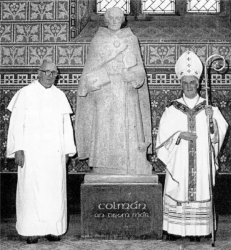
Dominican priest, Fr.
Henry Flanagan executed this striking
granite statue of St. Colman. He is
pictured here with Bishop Brooks at the
statue's unveiling, 3rd. November 1991.
Most Rev. Dr. John McAreavey was ordained
Bishop on Sunday 19th. September 1999 in Newry Cathedral by
Most Rev. Dr. Se�n Brady, Most Rev. Dr. F. G. Brooks and
Most Rev. Dr. John Magee. Early in his episcopate, Dr.
McAreavey had the Bishop's House renovated and extended. He
launched the new Parish Development Plan in Newry on the
8th. October 2000. The relics of St. Th�r�se of the Child
Jesus were formally received by him in Newry Cathedral on
the 23rd. May 2001, and a series of events were organised by
the various schools in the parish to celebrate this event.
Dr. McAreavey also instigated the annual parish and diocesan
pilgrimage to Knock in June 2001. He also arranged
`Listening' meetings in the parish - and throughout the
diocese - assuring parishioners that their ideas and issues
raised would receive urgent attention. On the 17th. July
2003, a formal relationship was formed between the Diocese
of Dromore and the Diocese of Lodwar in North Kenya which
was celebrated at a concelebrated Mass in Newry Cathedral.

The Cathedral of St. Patrick and St.
Colman
Situated in the centre of the city of
Newry, the stately Gothic Cathedral of St. Patrick and St.
Colman which graces the main street is proudly regarded by
all sections of the community as Newry's finest building and
stands as a silent witness to a century of hard struggle and
considerable sacrifice.
The original building was designed by
Thomas J. Duff, a native of Newry, and the renovation
undertaken during the episcopate of Most Rev. Dr. Henry
O'Neill, was designed by G. C. Ashlin (Ashlin and Coleman,
Dublin) with Denis Neary as builder. The latest renovation
undertaken during the episcopate of Most Rev. Dr. F.G.
Brooks, in order to bring the Cathedral in line with
the liturgical reforms promulgated by the Second Vatican
Council, was designed by Felix Forte of McLean and Forte,
Belfast. It extended the Sanctuary towards the congregation
where the altar would be in the best possible view from all
parts of the Cathedral.
The Cathedral is an architectural gem.
Cruciform in plan, the whole structure possesses an
architectural unity. It is built entirely of Newry granite
with a graceful well-proportioned facade with a Norman
arched doorway and octagonal twin Norman turrets. The square
sculptured granite tower over the northern transept is
entirely the work of local sculptors. An expansive terrace
of granite steps leads into it.
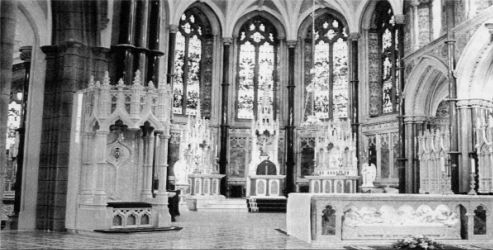
The sanctuary of the Cathedral
today. Bishop Brooks guided the project of
renovation and reordering, 1989-90. The new
altar was dedicated on 25th. November, 1990, the
Feast of Christ the King.
As one enters the Cathedral, one's eyes are immediately
drawn to the magnificent Sanctuary with its steps in
Botticino marble, carpeted in an Irish hand-woven
burgundy-shade carpet with a Celtic design border matching
the mosaic of the main aisle, opening up the Sanctuary on
three sides to the people. The tabernacle rests on a plinth
of white marble with panels of Breccia Pernice between
columns of Rosso Verona marble. The door, of handsome
wrought gold beset with coloured jewels, is covered with a
golden dome and sides. The two fine panels of the former
reredos rest on plinths matching that of the tabernacle.
They are mainly of Carrara and statuary marble, relieved by
columns in Siena and Verde Alpi marble and by small panels
in Porta Santa. They stand at angles to the tabernacle, the
left carrying a beautiful sculpture of the Nativity and the
right, a sculpture of Christ commissioning the Apostles. On
either side is a marble seraph carrying a torch. In the
front of the altar is a fine representation of Leonardo da
Vinci's "Last Supper" sculptured in Sicilian marble which
was formerly in front of the High Altar erected in 1891 as a
memorial to Dr. Leahy.

The beautiful pulpit in white statuary marble with a front
panel depicting the Sermon on the Mount was erected by Most
Rev. Dr. McGivern in the 1888-90 building scheme and now
forms part of the Sanctuary as it did then. The "Cathedra"
or Bishop's chair is of white statuary marble blending in
with the carved Carrara marble screens which divide the
Sanctuary from the side chapels of the Blessed Virgin Mary
and St. Joseph which are also erected in Carrara marble with
mosaics and marbles. A marble panel with the arms of the
diocese, the Blessed Virgin crowned and holding the child
Jesus, with the words "Monstra esse to matrem, matrem
ecclesiae Dromoren" (show yourself to be a Mother, the
Mother of the Church of Dromore) is on the back of the
throne.
The Sanctuary columns are of polished
stone, Newry grey and Balmoral red - and were polished
during the latest renovation. The exquisite silver Sanctuary
lamp above the main altar was the gift of Mr. John McAreavey.
The Sanctuary lamps in the side chapels were the gifts of
the Children of Mary Sodality (Our Lady) and James Fleming
(St. Joseph) respectively. The Sacred Heart Shrine was
erected by the Sacred Heart Fraternity and the magnificent
stained glass window, depicting scenes in the life of the
Holy Family, originally over the High Altar in 1880, was
presented by the Holy Family Fraternity.
The Cathedral walls from floor to
ceiling, the Sanctuary floor and the passages in the nave,
are entirely in mosaics, showing a variety of designs
including Celtic, fleur-de-lys and rose, which were washed
during the latest renovation. Set into the communion passage
are three symbols signifying the Blessed Eucharist the Chi
Rho, the Fish and the Pelican. In front of the altar is a
large panel in mosaic of Newry granite depicting a Celtic
Cross with the letters SPC (Saints Patrick and Colman). The
Sanctuary and side chapels are adorned with magnificent
stained glass windows.
The marble piet�, now placed in its own
niche at the side entrance, was a gift from the Boyd family.
The bell of the Cathedral, cast by the Dublin foundry of
Sheridan in 1862, was melted down and recast in 1987. Two
new joy bells were added to the peal and the inscription now
reads:- "This bell was recast in year I987 and named
Colman. When I call, hear my voice and come to the Sacred
Mysteries."
Thus, built in local granite and mainly
the work of local craftsmen, our Cathedral is an edifice
that is imposing in its architectural dimensions, inspiring
and prayerful in its wealth of artistic interior decoration
and eminently suitable for its prime function. It stands as
a fitting tribute to God and to the outstanding generosity
of successive generations of the people of Newry.

The Church of the Sacred Heart and
St. Catherine of Siena
Standing majestically above ground level,
this beautiful Church, conducted by the Dominican Fathers,
caters for those who live around Ballybot, Dominic Street,
Dominic Court, Francis Street, Peter's Place, Thomas Street,
Michael Mallon Park, John Martin Street, John Martin Place,
Kiln Street, James Connolly Park and also the many Catholics
around Newry who are affectionately known as the "Dominican
Catholics."
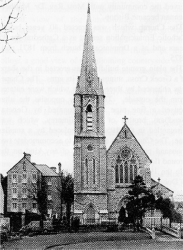
The Church of the
Sacred Heart and St. Catherine of Siena
was solemnly dedicated on 17th. October,
1875. The Dominican', as it is popularly
known, is served by a small community of
the Order of Preachers who reside at the
attached priory.
The foundation stone was blessed and laid by Most Rev.
Dr. John Pius Leahy on the 23rd. May 1873, the cost of
building up to dry-course level being the gift of a wealthy
Cork tanner. In Autumn 1875, the Church was completed and
the Holy Name Society organised the town into districts and
carried out a weekly collection, thereby clearing the
outstanding debt in a few years. The Church was solemnly
dedicated on the 17th. October 1875 at a Mass concelebrated
by Dr. Leahy and twenty priests. The
sermon on the occasion was preached by the famous Dr. Croke
of Cashel and the Holy Family band supplied much of the
music.
In 1885, the Quinn sisters presented a
high altar costing �1,240. The altar, executed in Sicilian
and white Carrara marble, is twenty-five feet high with the
reredos rising to six feet. The canopy and pinnacle were
hewn from a single block, weighing over one and a half tons.
The altar was consecrated by Most Rev. Dr. P.V. Flood O.P.,
Archbishop of Port of Spain. Then, on Saturday, 4th. August
1906, the Church was consecrated by Most Rev. Dr. Henry
O'Neill when the Misses Quinn gave the rights of freehold
forever to the Dominicans. The Quinn family also donated the
Altar of the Queen of the Rosary and the first organ as well
as having the apse adorned in mosaic and the entire building
decorated.
The Church of the Sacred Heart and St.
Catherine is beloved by Newry parishioners because of its
warm, prayerful atmosphere and its vibrant faith community.

St. Mary's Church
St. Mary's, affectionately known by all
Newry parishioners as "The Old Chapel", was erected in 1789
by public subscription at a cost of � 1,800. It replaced the
smaller Mass House which stood towards the north-west of the
adjoining cemetery which had served the community until Most
Rev. Dr. Matthew Lennan became Bishop.
The Church which was erected 40 years
before Catholic Emancipation served as a Cathedral for 35
years and as a Dominican Church from 1871 until 1875.
The plain granite building was erected in
the shape of a Greek Cross, minus one of its arms. The
Chapel was enhanced by three galleries which were entered
from the outside. The gallery opposite the altar housed a
fine pipe organ, donated by General Needham, brother of Lord
Kilmorey, which was dismantled in the 1950s and replaced by
a smaller one. The Church was calculated to accommodate two
thousand people, with no seats of any kind on the ground
floor.
In the 1950s, during the episcopate of
Dr. Eugene O'Doherty, many renovations took place. New
seating was installed, providing seating for a thousand
people. The two large statues of the Sacred Heart and St.
Joseph were removed from plinths flanking the altar to
niches under the organ gallery.
In 1954, the beautiful statue of Our Lady
at the side gate was erected from money collected by the
local people. In 1956, Rev. Aengus Buckley O.P. was
commissioned to paint the Stations of the Cross which were
blessed and solemnly erected on the 2nd. December 1956 by
Dr. O'Doherty. That year also, a
replica of Calvary was erected at the
southern end of the cemetery.
Further renovations took place in
1995-1996 when the entire sanctuary area was revamped and a
magnificent new altar installed which was dedicated on the
24th. March 1996 by Most Rev. Dr. Brooks. The entire Church
was also repainted. The graceful illuminated statue of Our
Lady on the exterior of the building serves as a beacon of
hope and protection to those who pass by.
St. Mary's, beloved of all Newry
parishioners, with its beautiful rose windows and prayerful
intimacy, gives eloquent testimony to the sacrifices of the
Newry community and their unswerving loyalty to the faith of
their forebearers.
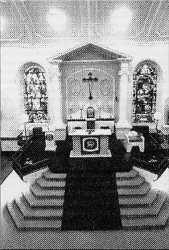
The
beautifully appointed sanctuary
of St. Mary's Church. A major
renovation of the Church took
place 1995-96. It was
re-dedicated on 24th. March
1996.

St. Brigid's Church, situated on a mound
of high ground overlooking the whole Newry valley with the
Camlough Road to the west and the Armagh Road to the east,
serves the parishioners of Rooney's Meadow, Derrybeg and the
Armagh Road.
St. Brigid's Church, Rooney's
Meadow, has the largest seating capacity of any
church in the Dromore Diocese. It was built
1968-70 to serve the 'Meadow' district of Newry
which had expanded rapidly in the 1950s and 60s.
The Church, which was built at a cost of
�200,000 and caters for 1,200 people, replaced a temporary
Chapel-of-Ease at Rooney's Meadow which served the people of
the area since the 21st. December 1958. The site of the new
Church was blessed and the foundation stone laid by Most
Rev. Dr. Eugene O'Doherty on Thursday, 13th. June 1968, and
was opened for Sunday Mass on Sunday, 14th. June 1970. The
Church was formally opened by Dr. O'Doherty on the 18th.
October 1970 at a concelebrated Mass by Dr. O'Doherty and
ten native Newry priests, which was presided over by His
Eminence, Cardinal William Conway, and was attended by Most
Rev. Dr. William Philbin, Bishop of Down and Connor,
representatives of other Christian denominations in Newry,
and Catholic clergy from the Dromore and Armagh dioceses.
The large Sanctuary area with its
freestanding altar of unpolished Newry granite which is the
unobstructed focal point of the Church, is floored with
golden travertine marble and white and golden brown mosaics.
The Baptismal Font of Newry granite has been placed near the
Sanctuary area. The four evangelists in symbolic form,
carved by Mr. John Haugh, overlook the Sanctuary area.
Four confessionals, simply designed in
mahogany.. are placed on the sides of the Church, recessed
from the aisles. The Stations of the Cross are of Italian
design with figures in cast aluminium and crosses in natural
mahogany.
The front entrances are deliberately
prominent and significant. Each is 15ft. gins.
wide by 23ft. high and contains double doorways. These
wide-open doors, reflecting the Irish tradition of
hospitality and with an unobstructed view of the Sanctuary
area, offer a warm welcome to parishioners summoned to
prayer by the mellifluous tone of the Church bell.

Mass Rocks in the
Parish of Newry
During the Penal era, when Catholics were
forcibly dispossessed of their Church property by oppressive
laws, debarred from preserving records and forced to
practise their religion in secret, the people of Newry, as
elsewhere, selected Mass Rocks where the Mass could be
celebrated in relative safety. These Mass Rocks were
frequently selected at a spot where a suitable slab of rock
served the purpose of a natural altar while simultaneously
affording some safety and a good view of the surrounding
countryside. Sometimes, it was secluded and sheltered by
growth but, more frequently, it was a hollow spot on an
eminence. From the surrounding fringes of this hollow, a
good view of the adjoining countryside was generally
afforded, while the assembled congregation could only be
visible from above.
In a hollow space on top of Ballyholland
Hill in the townland of Ballyholland Upper, a rock forming a
natural altar is situated, known as the Ballyholland Mass
Rock, which was in use for some time before 1750. A memorial
cross was erected over the altar in 1918 and a new altar in
natural stone was blessed by Most Rev. Dr. Francis Gerard
Brooks on the 19th. June 1988.
The first procession to the Ballyholland
Mass Rock was conducted by Rev. T. McGrath C.C. on the 1st.
August 1909, under the auspices of the P.T.A.A. An elaborate
wooden altar was constructed for the occasion. In 1932, on
the 19th. June, there was an international flavour when, for
the first time since the Penal Times, Pontifical High Mass,
attended by at least four bishops, was sung. In 1950, to
celebrate the Holy Year, Mass was again offered by Most Rev.
Dr. Eugene O'Doherty who also celebrated Mass there in 1954
to celebrate the Marian Year. Since then, Mass has been
celebrated by the Bishop at the annual Mass Rock pilgrimage.
According to tradition, the old cemetery
in Grinan, known as Clonlea, was used for the celebration of
Mass until the end of the eighteenth century. An ancient
Cross in plain granite, said to date back to the time of St.
Patrick, is still to be seen in the cemetery. The adjoining
part of the townland to the northwest is known as "The
Priest's Quarter." In 1794, Rev. Dominic McEvoy, the
registered parish priest of Newry, resided in this locality.
A small Mass House, sixty by thirty feet,
was erected in St. Mary's Cemetery in Newry, circa 1730, and
served the people until St. Mary's Church was built.
A Franciscan priest delivers
his sermon (above), at Mass Rock Sunday in
Ballyholland, in the 1950s. Bishop Eugene
O'Doherty (below), leads the Rosary on the same
occasion.

St. Patrick's Primary School
On Tuesday 17th. March 1959, Most Rev.
Dr. Eugene O'Doherty laid the memorial stone of St.
Patrick's Primary School, Rooney's Meadow. The ten-classroom
school, accommodating 384 pupils, cost approximately �60,000
and was blessed and officially opened by Dr. O' Doherty on
Monday 11th. January 1960. Circa 1964, the school was
further extended to become an eighteen-room school and on
the 27th. May 1999, a new nursery unit was opened.
St. Ronan's Primary School
St. Ronan's co-educational Primary
School, situated in Ashgrove, Newry, was the first Catholic
school to benefit from full government funding. Costing �
1,250,000 and owned by the Parish, St. Ronan's was
officially opened and blessed by Most Rev. Dr. Francis
Gerard Brooks on the 18th. October 1994. Currently catering
for 385 pupils ranging from PI - P7 with a two stream entry,
it has fourteen fully-equipped classrooms and a
special-needs' room and is staffed by 14 full-time and one
part-time teacher.
St. Clare's Primary School
After their arrival in High Street on the
2nd. June 1830, the Sisters of St. Clare directed their
attention towards the building of a school. Consequently, on
the 12th. August 1830, the foundation stone was laid. This
was an attempt to enhance the career prospects of the poor
as there was much poverty in the Newry area in the early
1800s. By 1831, there were 400 pupils in attendance and, by
1853, the building was completed with 500 pupils in
attendance. A local newspaper praised the Sisters for
'their instruction of poor ,female children in
the ways of virtue and for rescuing the orphans. " The
older girls were taught embroidery and lace-making. The
pupils became so adept at this task that, in the 1850s, they
won prizes at the International Industrial Exhibition in
London. As for their academic ability, a National Education
Board Inspector wrote in 1852: "All the classes must be
highly commended on their proficiency in reading, writing,
arithmetic and geography. Their answering evinced a
readiness and proficiency quite astonishing in ones so
young."
In 1894, a two-storey building was
erected which catered for girls and boys up to the age of
nine years initially and, later, seven years of age, when
they transferred to the Abbey Primary School. Since then the
school has had an admirable record for catering for the
spiritual and academic needs of its pupils.
At present, the existing buildings
urgently need to be replaced and the school is moving
towards an amalgamation with the boys of St. Colman's Abbey
School.
Ballyholland Primary School
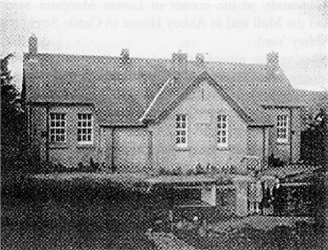
Records and folklore recall a hedge
school near Grinan. In general, however, attendance was poor
as Ballyholland and its environs was a relatively poor
locality, densely populated, surviving on subsistence
agriculture, where pupils had to pay the teacher. Even when,
by 1902, elementary education was free and attendance at
school was compulsory up to the age of twelve years,
attendance remained sporadic.
Ballyholland was served by two schools,
Grinan and the Commons. Many children also attended both the
Christian Brothers' and Poor Clares' Primary Schools.
However, when Grinan was in danger of closing due to lack of
finance during World War I, the local families withdrew
their children from Newry - and, in some instances, from the
Commons - and sent them to Grinan.
However, the need for a larger school
soon became apparent. A site near Ballyholland cross-roads
was obtained and work began in 1920 on a large stone
building with three classrooms, all modernly furnished.
In 1965, the school underwent its first
renovation which provided four new classrooms. In 1983, an
extension was built providing four extra classes and a large
dining/assembly hall. Today, there are three new mobile
classrooms due to an expansion in the number of pupils - an
obvious testament to the quality and commitment of the
staff!

St. Joseph's Convent Primary School
The first Primary School opened by the
Sisters of Mercy was in Canal Street in 1865. In 1876, an
Orange Lodge was purchased beside the Primary School where
young boys up to the age of seven years were taught.
However, as numbers increased and as Our
Lady's Grammar School needed more space, the Sisters began
looking for an alternative site. In February 1926, property
in Edward Street adjacent to the Convent was purchased. The
Infant School, consisting of six large rooms, divided by
folding doors, two cloakrooms and two toilet blocks, was
blessed and opened by Most Rev. Dr. Edward Mulhern on the
27th. October 1927. In 1934, further classrooms were built
in Edward Street on the site of an old foundry. This
red-brick building, now known as the Junior School, was
designed to accommodate between 300 and 400 pupils. On
Thursday 25th. April Ballyholland Public Elementary School
was opened in 1921. Situated on the border of Upper
Ballyholland and Grinan townlands, the school was extended
in 1965 and, again, in 1983.
1935, Dr. Mulhern blessed and opened the
school. During the Principalship of Sr. M. Cecilia O'Doherty
(1947 -1957) as the number of pupils had increased, the
existing Sodality rooms were converted into two extra
classrooms.
When St. Patrick's School, Rooney's
Meadow, opened, the boys attending St. Joseph's School were
requested to enrol in the new school, thus leaving St.
Joseph's an all-girls' school. During the Principalship of
Sr. M. Angela Rafferty (1957-1966), the Sisters bought land
adjacent to the school bit by bit, and in 1967, a spacious
new playground was made available for the children, partly
financed by the Department of Education.
As the student population increased,
additional temporary classrooms were erected and the entire
school was equipped with modern facilities for every
subject. In 1983, a much needed fire-escape was erected and
fire-alarms and fire-doors were installed throughout the
school.
During the early 1980s, the enrolment
declined and in 1988, two classrooms underwent extensive
renovations to become a diagnostic unit. In 1992 and 1993,
two extra mobile classrooms were added to the school to
reduce numbers in some classes and to enable the staff to
deliver the ever-changing curriculum more efficiently. A
nursery unit opened on the 24th. September 1997, and on the
1st. September 1999, boys were admitted to Primary 1, and
thus St. Joseph's has become once again a co-educational
school, catering for all aspects of Primary education.

St. Colman's Abbey Primary School
The Christian Brothers began their
teaching career in Newry in Upper Chapel Street in 1851
where there was a Lancasterian-type school under the care of
Master Gorman. They then functioned in Kilmorey Street, the
Free Trade Hall in Castle Street, the
`Carstands' at the corner of Lower
Margaret Street and the Mall and in Abbey House in Castle
Street and Abbey Yard. � During the nineteenth and well into
the twentieth century, the Brothers in Newry had no teaching
income but depended on the parish and other means of support
as they refused to operate the National School system which
was very pro-British and which restricted the use of
religious emblems and practices! Times were not easy in the
1930s as Newry was beset with problems associated with
endemic unemployment. Therefore, it was a far-reaching and
far-seeing decision for the Brothers to build a new Primary
School in the Abbey grounds. Nevertheless, they took that
decision, planning to accommodate all of their primary
pupils - circa 800 boys - in one building comprising 15
classrooms, 2 special subject rooms and an Assembly Hall
with an immense basement under the classrooms to be utilised
as a recreation ground in wet weather. The cost of �25,000
was to be borne equally by the Ministry of Education and the
townspeople.
On the 17th. March 1937, Most Rev. Dr.
Edward Mulhern blessed and laid the foundation of the new
St. Colman's Abbey Public Elementary School. The following
year, on the 7th. June, the imposing building was opened by
Dr. Mulhern. The Brothers contributed �2,400 plus the site
and their extensive recreation field while the people of
Newry contributed �8,000. In November 1958, work on the new
dining hall began and in June 1964, St. Colman's began to
take in infant boys. Three temporary classrooms were erected
in August 1964 at a cost of � 1,360, and the following year,
the classrooms in the old Grammar School building were
utilised by the re-organised Primary School classes. By
September 1969 there were 938 pupils attending the school
and, in August 1972, when the Brothers took up residence in
the new Monastery, the old Monastery was used to accommodate
some Primary School classes.
In keeping with their commitment to the
disadvantaged, the Brothers opened a special unit for the
physically handicapped in December 1976 and six pupils were
admitted. Due to an increase in numbers, a second unit was
provided. The unit now contains two classrooms, each adapted
to facilitate the needs of disabled students. Children aged
4-11 years are taught in the Primary class while, in the
Senior class, students aged I 1-19 years are taught.
Therapists attend the unit each week.
By 1996, the Brothers had ceased their
teaching apostolate in St. Colman's Abbey Primary School,
but their legacy lives on. As educators, they ensured that
the post-war generation of Catholics in Newry took full
advantage of the new educational opportunities available and
they gave their students the sense of self-esteem which is
an essential prerequisite for educational advancement.
The school is now set to link up with St.
Clare's Primary School to form a new co-educational Primary
School where the legacy of both these great Orders will,
without doubt, survive.
St. Mary's High School
Built on an elevated site purchased from
the Magennis family and commanding a very beautiful view of
the whole Newry district extending to the entrance of
Carlingford Lough, St. Mary's High School has built up a
tradition for Christian living and excellent academic
achievement of which the parish community can be justly
proud.
On Monday 4th. September 1961, the school
was blessed and opened by Most Rev. Dr. Eugene O'Doherty.
Under the joint care of the Sisters of St. Clare and the
Sisters of Mercy, the school opened with 644 pupils at a
cost of �175,000 and caters for the spiritual, intellectual
and physical formation of each pupil in a warm, caring
atmosphere.
Adapting to the changes in education, a
large extension costing �270,000 and consisting of seven
classrooms, three Domestic Science rooms, two Science rooms
and a dining hall cum servery was blessed and opened by Most
Rev. Dr. Francis Gerard Brooks on Wednesday, 7th. January
1976. A new Technology Suite and a Science Block were added
later. At present, the school is introducing A-level
vocational subjects to the curriculum.
The school is a Catholic maintained
school with a current enrolment of 535 pupils, aged 11-17
years, and a staff of 35 who strive to enhance the learning
opportunities for each pupil as well as devising strategies
to motivate them. This commitment, together with the
progressive vision, management and curriculum of the school,
is responsible for the high academic achievement and the
mature outlook of its students.

St. Joseph's High School
St. Joseph's, the first Voluntary
Intermediate or High School in the Diocese of Dromore, can
be extremely proud of a host of past-pupils and staff who
have had a major impact in many spheres of life - business,
sport, academia, religious, drama and public life/politics.
On Monday 19th. March 1956, Most Rev. Dr.
Eugene O'Doherty laid the foundation stone of St. Joseph's
Catholic Boys' Intermediate School on the Armagh Road,
Newry, and two years later, on Monday 6th. January 1958,
officially opened it. The school, designed by McLean &
Forte, Belfast, cost approximately � 180,000, and had
accommodation for 500 pupils.
Since then, the school has served the
parish of Newry well. Composed of thirty-seven rooms,
staffed by twenty-eight teachers with a current student
population of 471, the school provides an excellent
education for pupils of all ability.
It has an excellent pastoral dimension, a
rich and diverse curriculum and a dedicated staff, all of
which enable its pupils to achieve their potential and to
take their place confidently as responsible citizens and
leaders in today's society.
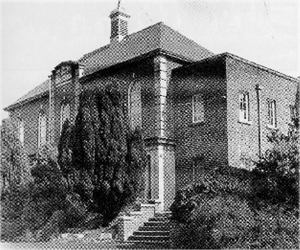 |
 |
|
The Christian Brothers began
their long association with education in Newry
when they started teaching in Upper Chapel
Street in 1851. Almost a century later they
opened St. Colman's Public Elementary School, in
the grounds of their monastery, in June 1937. |
The late 1950s saw the building of several new
secondary modern schools within the Dromore
Diocese. St. Mary's Girls' High School, situated
in Upper Chapel Street, belongs to this period.
It was officially opened on 4th. September 1961. |
The Abbey Grammar School
When the Christian Brothers took
possession of the Abbey House and grounds on the 1st. April
1903, they resided in the "Master's House" where, nearby,
they had reasonable accommodation for their Secondary School
pupils in the Castle Street and Abbey Yard areas. Secondary
level education had to be more or less self-financing until
the 1947 Act, but the Brothers did not exclude any student
whose parents were unable to pay the small basic fee.
The old Abbey Secondary School had a
woodwork room, a science room and a gym. However, the work
progressed and as the number of students increased, the
facilities also improved and the academic excellence of the
pupils was widely recognised. In the early 1960s, it became
apparent that the existing school could no longer cater for
the number of students and it was decided to build a new
school.
On Wednesday 28th. September 1966, the
new building, built on the site of the old Cistercian
Monastery and costing circa �260,000, was blessed and
officially opened by Most Rev. Dr. Eugene O' Doherty.
In February 2003, the Abbey Grammar
School -now in lay hands - secured �12.23 million from the
Department of Education to build a new school which will no
doubt, continue to maintain the highest academic standards
and the spirit of Christian concern which has always
permeated the Newry schools managed by the Christian
Brothers.

Sacred Heart Grammar School
As a result of the development of the
educational system and recognising the need for higher
education, the Sisters of St. Clare decided to open a
Secondary School. This they did in 1925 in the Primary
School building. In 1925, they bought a plot of ground in
Castle Street and commenced building a new school in 1928.
In August 1930, the new building was opened with an initial
enrolment of 70 pupils and 4 lay staff.
As numbers increased, various other
buildings and mobile classrooms were introduced and the
Principalship passed into the hands of the Sisters. Major
developments in the field of education and ever-increasing
numbers of students rendered the original site in High
Street and Castle Street inadequate and on the 2nd. December
1985, the present Grammar School at Ashgrove, a magnificent
purpose-built complex, costing �3,000,000, set in extensive
grounds with scenic views of Newry and the surrounding
countryside, was officially opened. A further extensive new
Science and Technology Block was opened on the 23rd. June
1997.
At present the school has an enrolment of
875 pupils with 54 full-time staff. The school offers a
framework in which every girl has the opportunity to develop
a caring, self-confident, well-informed and balanced outlook
as well as providing a first class academic education in a
caring, christian environment.
Our Lady's Grammar School
Monday 21st. November 1887, was an
eventful day for the Sisters of Mercy in Newry and for nine
young students who made history when Our Lady's Intermediate
School, as it was then called, opened its doors for the
first time with Sr. M. Philip Magennis as Headmistress.
Some time previously, Most Rev. Dr.
Thomas McGivern, Co-Adjutor Bishop of Dromore, had asked
Rev. Mother Emmanuel Russell, sister of Lord Charles Russell
of Killowen, the first Catholic ever to become Lord Chief
Justice of England, to open an Intermediate School for the
Catholic girls of Newry which was then a very thriving port
and commercial centre with good canal and railway systems.
With a population of 15,590 and with steamers arriving daily
at the Albert Basin, Newry was quite cosmopolitan and had
consuls for the Netherlands, Sweden, Norway, France and
Italy. Hence the need for a Catholic Intermediate School to
complement the Protestant one on the Downshire Road.
Classes were conducted in the lower floor
of the Convent at first, but as numbers increased, the need
for a permanent school became apparent. Thus in 1894, Our
Lady's School was begun and the first pupils moved in after
the Summer holidays of 1895. The new school, adjoining the
National School, was at the bottom of the Convent garden and
consisted of one large room (fifty feet by thirty feet)
called Our Lady's Room with a smaller room used for music
lessons.
The curriculum was quite varied -
English, French, German, Latin, Arithmetic, Algebra,
Geometry, Singing, History and Historical Geography were
studied by all pupils, while Drawing, Painting and
Instrumental Music were optional. Religious Education was
taught for half an hour every day and those preparing for
the Civil Service were introduced to shorthand. Irish and
Irish dancing were introduced into the curriculum at a later
stage. The students sat the examinations of the Intermediate
Board, Dublin. One student, Marguerite Magennis, became a
University graduate having completed all her University
course at Our Lady's!
As the numbers increased, additional
classrooms were added and when the National School moved to
Edward Street, Our Lady's acquired their premises. Our Lady
of Lourdes Boarding School was flourishing by this time,
having opened in 1918 in response to a request by Most Rev.
Dr. Edward Mulhern. This boarding school, housing at one
stage 74 boarders, flourished until June 1971 when, due to
improved public transport and lack of space for the
ever-expanding school, it was closed on the recommendation
of Most Rev. Dr. Eugene O'Doherty and Our Lady's occupied
the premises.
As the school and curriculum expanded,
the need for new premises became more urgent and
negotiations began in the early 1960s with the Department of
Education. However, it was riot until the 1987-88 academic
year that government approval for the new school was
obtained.
The site in Chequer Hill, which had been
bought by the Sisters several years beforehand, was blessed
by Most Rev. Dr. F.G. Brooks on the 21st. November 1988 and
work commenced. Then, in September 1992, the whole school
community moved into the modern, architecturally beautiful,
spacious building. The magnificent, multi-storeyed complex
was blessed by Most Rev. Dr. F.G. Brooks and officially
opened on the 21st. November 1992.
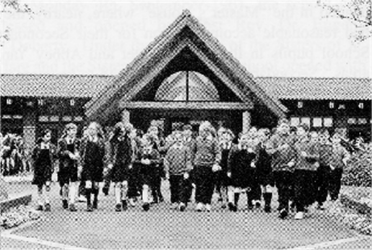
Happy pupils at St.
Ronan's Primary School. St. Ronan's,
located at Ashgrove Avenue, was the
first Catholic school in the Dromore
Diocese to benefit from full government
funding. It opened in 1994.
The next big milestone in the history of
Our Lady's occurred on the 31st. August 1997 when Sr. M.
Perpetua McArdle retired as Principal and the first lay
Principal, Ms. Geraldine Pettigrew, a native of Newry and a
past pupil of the school, was appointed to succeed her.
Students are encouraged to develop
themselves spiritually, emotionally and academically, and
the importance of spiritual values and concern for others is
woven into the fabric of everyday school life. Every effort
is made by a dedicated Principal and staff to provide a
warm, caring atmosphere and to equip the students to become
confident, competent, professional, compassionate adults who
are ready to play their part in shaping the future of
society.

St. Colman's College
Due to the Penal Code, a determined
attempt was being made to crush the priesthood out of
existence and to keep Catholics in general poor, socially
degraded and politically impotent through non-availability
of Catholic education. Hence, Catholic education assumed an
acute and vital importance.
Most Rev. Dr. Matthew Lerman (1780-1801)
and Most Rev. Dr. Edmund Derry (1801-1819) were both deeply
interested in the question of Catholic Primary School needs,
but also in the educational training of aspirants to the
priesthood. The former left a bequest for educational
purposes in his will while the latter, as we have seen, was
responsible for the foundation of the diocesan seminary
called "The Newry School." This was followed by the
foundation of the Diocesan Seminary by Most Rev. Dr. Hugh
O'Kelly, which was conducted by Rev. John Sproule Keenan.
The Diocesan Seminary, or "School of
Dromore" as it was originally known, was opened in William
Street in May 1823, and is the oldest existing diocesan
seminary in Ulster. When Dr. O'Kelly rented the house in
William Street, he had in mind both the training of
candidates to the priesthood and also the education of the
sons of the Catholic middle-class and relatively wealthy
land-owners. Newry was an excellent choice at this period as
it was an important river port and manufacturing town. It
was also on the main coach road between Dublin and the
North. It had a large Catholic population with a Catholic
hinterland and had become an Episcopal seat.
The presidency of Fr. Keenan in the
Diocesan School of Dromore was to herald the inauguration of
St. Colman's College as we know it today. In May 1829, the
school transferred to premises on the northern side of
Courtenay Hill. Although the oldest part of the present St.
Colman's was rented in 1829, classes continued in Courtenay
Hill until 1866, except for a brief period in 1837 when the
house in William Street was again in use.
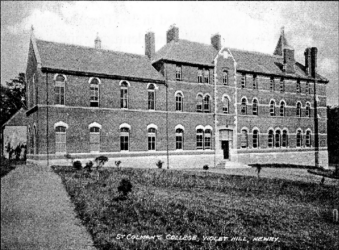
St. Colman's College
in 1922. The College began its life at
premises it Newry's William Street in
May 1823. It is the oldest existing
diocesar seminary in Ulster.
Most Rev. Dr. Michael Blake purchased the
land of Violet Hill, consisting of eighteen statute acres,
on the 23rd. September 1834. Extra land was bought bit by
bit and by the 30th. December 1937, the College had almost
fifty statute acres. Following the purchase of Violet Hill
and its grounds, Dr. Blake and Fr. Keenan set about
extending the College. The eastern front, in which the
Bishop's residence was situated, was built in 1835. Fr.
Keenan left the College in the Summer of 1835, his greatest
achievement being the great impetus he gave to the higher
education of Catholics. Fr. Mark Murphy succeeded Fr. Keenan
as President from 1835 until November 1837 when Dr. Blake
separated the lay and clerical facilities and made each an
independent institution. His intention was that the Seminary
- under the title of "St. Colman's Ecclesiastical Seminary"
- should be run on continental lines., He himself and
advanced ecclesiastical students superintended the seminary.
There was a flat rate of � 17 per annum for all boarders
which was increased to �20 per annum circa 1850. Two notable
developments took place during Dr. Blake's stewardship: the
students began to get holidays in the 1840s and the numbers
went down drastically.

When Most Rev. Dr. John Pius Leahy O.P.
succeeded Dr. Blake (1860-1890), the two institutions were
reunited in 1864 as "St. Colman's Diocesan and Catholic Day
School" under the presidency of Fr. Arthur Finnegan and the
numbers increased once more. Two years later, in 1866, the
town house was abolished and all the work of the institution
took place in Violet Hill. The tower was erected in 1876.
The appointment of Rev. Henry O'Neill as
President (1869-1890) marked the beginning of a new era of
advancement in the history of the seminary with large-scale
extensions to the College buildings - a magnificent building
from the front door to the college tower was completed in
1879 - and the introduction of the Intermediate system of
education in 1879. He built up a competent staff, including
Michael Cusack - who later founded the Gaelic Athletic
Association - and changed the name of the College to "St.
Colman's Diocesan College." The new entrance to the College
and the college library were built in 1880.
Further renovations during the episcopate
of Most Rev. Dr. Edward Mulhern included a temporary Chapel,
study hall, dormitory, a new laboratory and a geography
hall. Then, in 1936, the new College Chapel was begun on the
9th. December through the beneficence of Mr. Henry McEvoy,
Lenish, Clonduff, who paid for the entire fabric with the
request that it be dedicated to Mary, the Immaculate Mother
of God. It was formally opened by Dr. Mulhern on Wednesday
26th. October 1938.
During the years 1958-1961, the wing to
the east end of the College front was built, providing much
needed classrooms, Assembly Hall and dormitories. Further
large extensions took place in 1972 and 1994, providing
state-of-the-art facilities for the College.
The College reflects the changing times
in its styles of architecture which are, however,
harmoniously blended together creating a large, unified
building complex which has its main focus in the new central
quadrangle. The College has grown from strength to strength,
striving to educate the complete man through all his
faculties - spiritual, ethical, physical and intellectual -
and to prepare its students to play a leading role in all
spheres of society.
 |